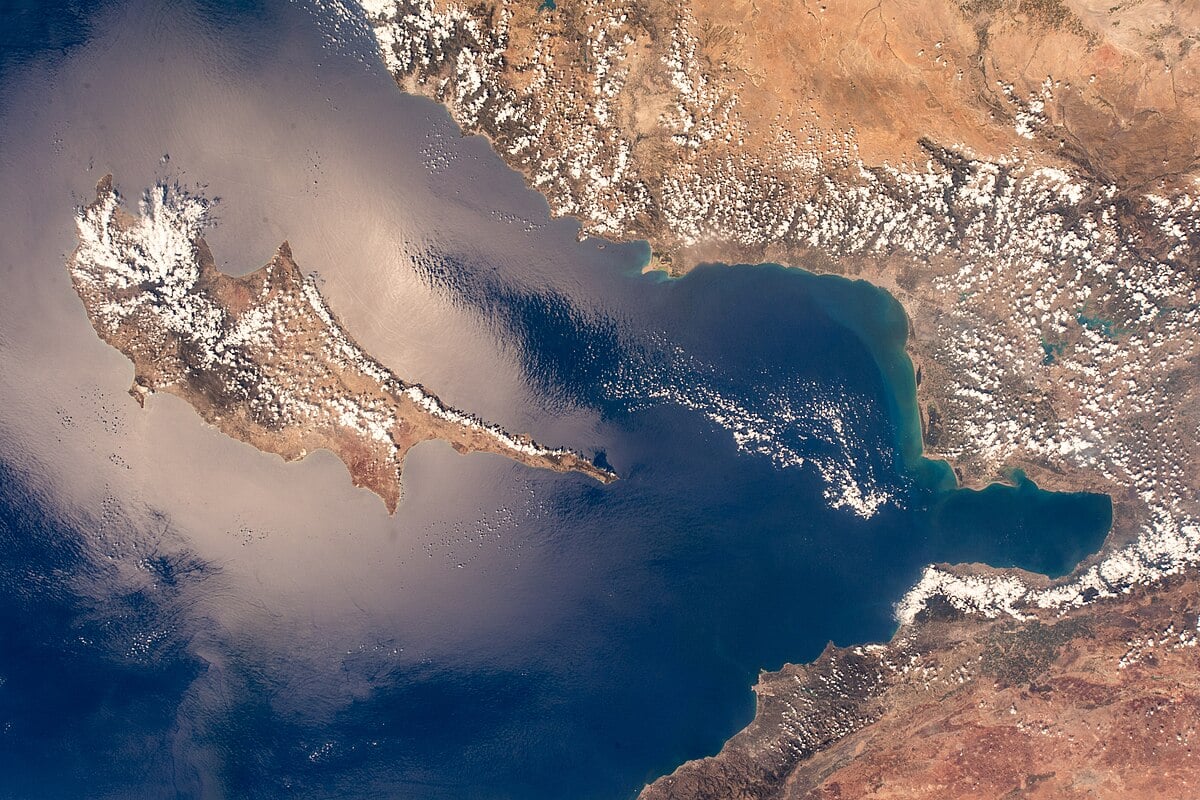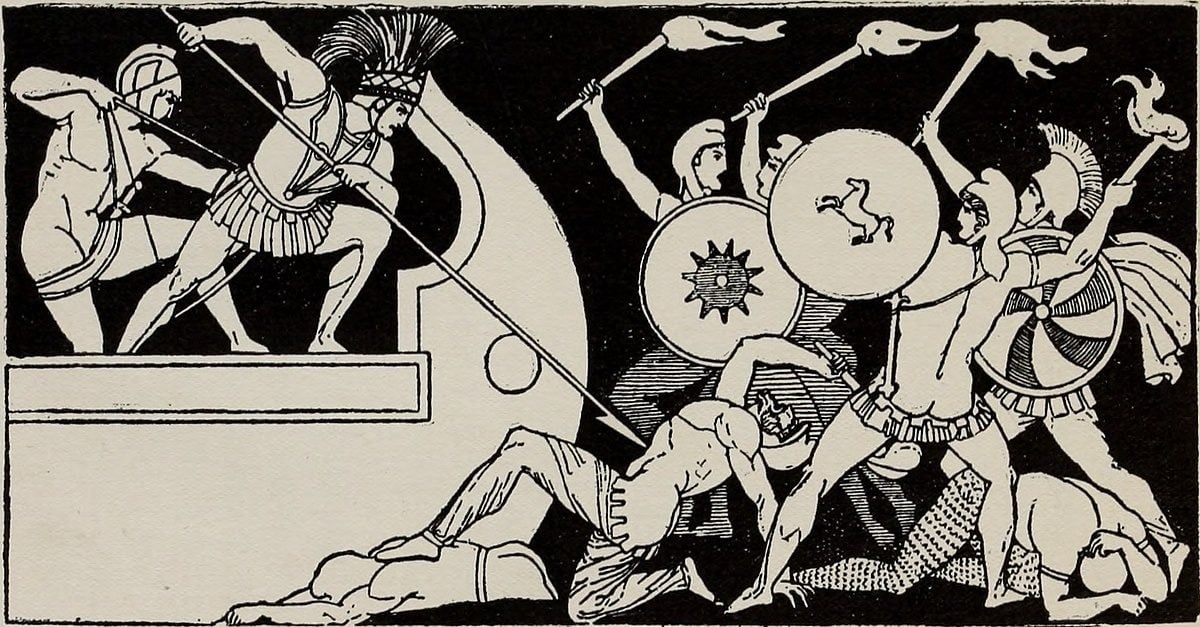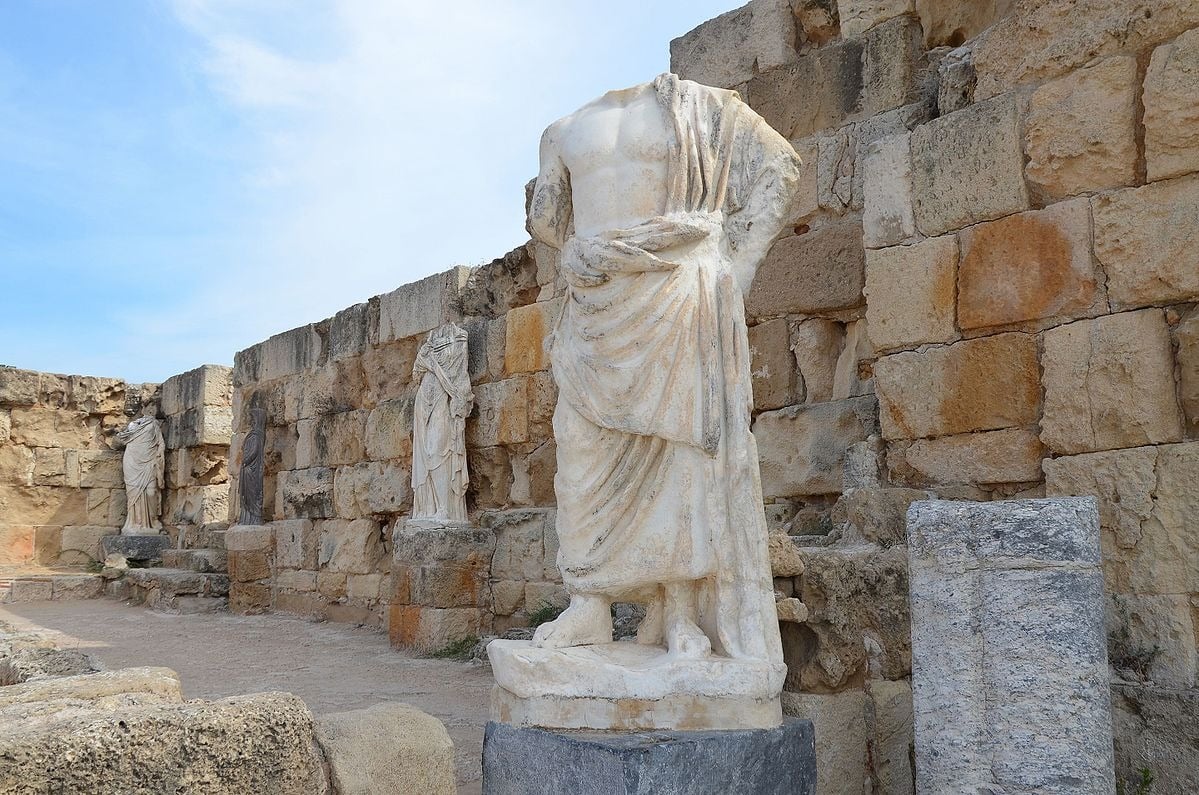

“Geography is destiny,” the 14th-century Islamic scholar Ibn Khaldun is believed to have said. This aphorism certainly rings true for Cyprus, which, owing to its location, has been a geopolitical hot zone for centuries.
Cyprus’s strategically important position in the Eastern Mediterranean has made it a geopolitical prize for rival polities, kingdoms, and empires throughout most of its recorded history. Situated at a vital point for trade and maritime power projection, the island has been the heart of countless imperial tugs of war.
Cyprus has been controlled by a succession of civilizations and empires, including the Mycenaeans, Phoenicians, Assyrians, Egyptians, Persians, Greeks, Romans, Byzantines, Arabs, Crusaders, Venetians, Ottomans, and the British, before gaining independence in 1960.
This complex history has been a mixed blessing, fostering vibrant cultural exchange and a rich heritage while also exposing Cyprus to centuries of conflict, conquest, and political instability. With the world once again entering a phase of geopolitical uncertainty, the future of this enigmatic island and its people may well be as colorful as its past.
Cyprus’s location in the eastern Mediterranean, at the crossroads of Europe, Asia, and Africa, has made it a valuable strategic asset for controlling trade routes and naval operations. Its proximity to key maritime chokepoints, such as the Suez Canal and the Levantine coast, has allowed successive powers to project influence across the wider Mediterranean and Middle East. This has made Cyprus a key staging post for both military campaigns and commercial networks.
Cyprus has also been valued for its natural resources, particularly its rich copper deposits, which were highly prized in the ancient world and contributed to the island’s early wealth and trade. Timber from Cyprus’s forests was another valuable resource, essential for shipbuilding and military purposes. These resources attracted traders and invaders alike, making Cyprus a target for conquest and exploitation.
Cyprus’s geopolitical significance extends beyond trade and resources to its role as a foothold for military and political influence in the Eastern Mediterranean. Control of Cyprus has provided powers with a strategic base for monitoring and projecting force into the Middle East and North Africa, while also influencing regional politics and security. Its position has made it a valuable asset in the competition for dominance among Mediterranean and Middle Eastern powers, ensuring that Cyprus remains entangled in broader geopolitical struggles.

Cyprus’s strategic location and natural resources made it an attractive target for early settlers and emerging powers. The first known human activity on the island dates back to the Neolithic period (circa 8800 BCE), but it was during the Bronze Age (circa 2500–1050 BCE) that Cyprus became a focal point for trade and political competition. The island’s rich copper deposits—its very name is linked to the Latin cuprum (copper)—drew merchants and settlers from across the Eastern Mediterranean.
The early Bronze Age saw the development of urban centers such as Enkomi, which became hubs of trade and metallurgy. The Minoans from Crete are believed to have established early trade links, followed by Mycenaean Greeks who settled on the island around 1400 BCE. This period marked the beginning of Hellenic cultural influence, which would shape Cyprus’s identity for centuries. The collapse of the Mycenaean civilization around 1200 BCE led to a period of instability, but Cyprus maintained its importance as a center for copper production and trade.
During the late Bronze Age, Cyprus came under the influence of the Egyptian and Hittite empires, reflecting its status as a contested geopolitical asset. The arrival of the Sea Peoples and the decline of major Eastern Mediterranean powers around 1100 BCE opened the door for the establishment of independent city-kingdoms in Cyprus. These early kingdoms, such as Kition and Salamis, maintained strong trade links with the Levant and Aegean, setting the stage for centuries of cultural exchange and external competition for control over the island.
One of the most significant mythical figures connected to this era is Teucer, the semi-mythical son of King Telamon of Salamis. According to legend, Teucer fought in the Trojan War and later founded the city of Salamis on Cyprus, establishing a powerful Greek presence on the island. While his story is rooted in myth, the historical settlement of Salamis reflects the strong Greek influence and the migration of Greek-speaking peoples to Cyprus during this period. This blend of myth and history underpins Cyprus’s early role as a critical cultural and geopolitical crossroads in the Mediterranean.

Following the collapse of the Bronze Age civilizations, Cyprus entered a new era marked by the rise of city-kingdoms and deepening connections with the Greek world. By the 8th century BCE, these kingdoms—including Salamis, Kition, Paphos, and others—had developed distinct political identities while sharing a common Greek language and culture.
This period saw increasing contact with the wider Mediterranean, as Cypriot city-states traded with Phoenicians, Egyptians, and Assyrians. However, Cyprus’s prosperity and location also made it a target for imperial powers seeking control over Eastern Mediterranean trade routes and naval corridors.
By the 6th century BCE, Cyprus was absorbed into the expanding Persian Achaemenid Empire. The Cypriot city-kingdoms retained some autonomy but were required to pay tribute and support Persian military campaigns. Persian dominance persisted for nearly two centuries despite periodic revolts—most notably during the Ionian Revolt.
This changed dramatically with the arrival of Alexander the Great in the late 4th century BCE. As he dismantled the Persian Empire, Cypriot cities aligned themselves with his campaign, contributing ships and troops in exchange for greater autonomy and favor. After Alexander’s death, Cyprus became entangled in the wars of the Diadochi, as his successors fought for control of the eastern Mediterranean.
Control of the island eventually passed to the Ptolemaic dynasty of Egypt, making Cyprus a vital naval base and political outpost in the struggle against rival Hellenistic powers, particularly the Seleucids. Ptolemaic rule brought a period of relative stability and economic integration with the Hellenistic world until Cyprus was absorbed into the Roman Republic in 58 BCE.
As a Roman province, Cyprus was a key administrative and military center, valued for its resources, harbors, and strategic location near the volatile eastern frontier. While nominally distant from the heart of Roman politics, Cyprus remained a vital imperial asset—its ports and position continuing to shape regional power dynamics through antiquity.

Despite the fragmentation of the Roman Empire, Cyprus remained a part of the Eastern Roman Empire (often referred to as the Byzantine Empire) for several centuries. Its strategic position in the Eastern Mediterranean—between the Byzantine heartlands and the rising Islamic caliphates—made it both a valuable outpost and a frequent target.
In the 7th century, Arab raids intensified, and for over 300 years, Cyprus was the subject of an unusual and unstable arrangement: a joint Byzantine-Arab condominium, in which both empires claimed authority over the island. Though often contested in practice, this period highlights the island’s geopolitical value to rival powers seeking maritime and military leverage in the region.
By the late 12th century, the island’s fate was reshaped by the Crusades. In 1191, Richard the Lionheart of England captured Cyprus during the Third Crusade, recognizing its strategic utility as a staging ground for campaigns in the Levant. Shortly thereafter, he sold it to the Knights Templar, who struggled to govern it, and quickly resold it to Guy of Lusignan, a former king of Jerusalem. Under the Lusignan dynasty, Cyprus was transformed into a Latin Christian kingdom and a key link in the Crusader supply chain. The island flourished as a commercial and naval hub, attracting European merchants and military orders while serving as a forward base for Western influence in the Eastern Mediterranean.
Cyprus’s geopolitical role became even more pronounced as Crusader strongholds on the mainland fell to Muslim forces. By the 14th century, it was the last significant Latin Christian foothold in the region and increasingly caught between the ambitions of Genoese and Venetian maritime powers. In 1489, the island was ceded to the Republic of Venice, which sought to control its trade routes and fortify it against the rising Ottoman threat. This transition marked the end of medieval independence and set the stage for a new era of imperial competition, as Cyprus once again became a battleground for control over the Eastern Mediterranean.

The early modern period marked a new chapter in Cyprus’s long history of strategic contestation. In 1571, the Ottoman Empire captured the island from Venice after an intense military campaign, most famously the protracted Siege of Famagusta. The conquest was part of the Ottomans’ broader push to dominate the Eastern Mediterranean and undermine Venetian maritime power. Control of Cyprus gave the Ottomans a critical naval outpost to monitor Christian fleets and project influence toward North Africa, the Levant, and the Aegean.
Under Ottoman rule, Cyprus was integrated into the imperial administrative structure as an eyalet (province). While the island retained local elites and a degree of autonomy under the millet system, power was concentrated in the hands of Muslim governors and military officials.
The Ottomans introduced new populations—Turkish Muslims and administrative classes—shifting the island’s demographic and religious balance. Economically, Cyprus declined relative to its earlier commercial prosperity, becoming more of a rural, tax-farming outpost than a dynamic trading hub. Yet its strategic location ensured continued relevance, particularly as the Ottomans engaged in naval and territorial rivalries with the Habsburgs, Venetians, and other European powers.
By the 18th century, Cyprus’s importance to the Ottomans had diminished, a casualty of shifting imperial priorities and the island’s limited economic output. However, for European powers with imperial ambitions in the Eastern Mediterranean, Cyprus remained a tempting asset.
As Ottoman influence began to wane and the Eastern Question emerged in European diplomacy, Cyprus quietly re-entered the strategic calculations of Britain and France—setting the stage for renewed geopolitical competition in the 19th century.

In 1878, Cyprus entered a new geopolitical era under British control. Through the secret Anglo-Ottoman Convention, Britain assumed administrative control of the island while nominally recognizing Ottoman sovereignty. The move was driven by strategic calculations: Britain sought to counter growing Russian influence in the Balkans and secure maritime routes to its crown jewel—India—especially in the wake of the opening of the Suez Canal in 1869. Cyprus offered a forward operating base near the Levant, Egypt, and the wider Eastern Mediterranean, giving Britain leverage in a volatile geopolitical theatre.
Although initially framed as a temporary arrangement, the British presence became permanent. After the outbreak of World War I and the Ottoman Empire’s alignment with the Central Powers, Britain formally annexed Cyprus in 1914. The island was declared a Crown Colony in 1925, cementing its status as part of the British imperial system. While Cyprus lacked the economic value of other colonies, its location made it strategically indispensable—a fortified outpost for naval operations, intelligence gathering, and imperial communications stretching from Gibraltar to the Persian Gulf.
Throughout the late 19th century, British policy in Cyprus was shaped more by regional power balances than by local development. The island became a pawn in the broader “Eastern Question,” as Britain and other European powers maneuvered to manage the decline of the Ottoman Empire while preventing any single actor—especially Russia or France—from dominating the Eastern Mediterranean. Cyprus thus played a quiet but important role in Britain’s imperial posture, serving as a strategic hedge as the Middle East and Balkans edged toward the geopolitical upheavals of the 20th century.

By the mid-20th century, Cyprus had become a geopolitical pressure point within the British Empire. Calls for enosis—the political union of Cyprus with Greece—gained momentum among Greek Cypriots, while Turkish Cypriots, fearing marginalization, advocated for taksim (partition). Caught in the middle was Britain, which saw Cyprus not just as a colony but as a vital Cold War asset.
In 1955, tensions erupted into armed conflict as the Greek Cypriot nationalist group EOKA (Ethniki Organosis Kyprion Agoniston) launched a guerrilla campaign against British rule, targeting both military infrastructure and political opponents. Led by George Grivas, EOKA aimed to end colonial rule and achieve enosis.
The British response was marked by counterinsurgency operations, arrests, and curfews. Yet, by the late 1950s, it became clear that the costs of holding Cyprus outweighed its benefits. With Cold War tensions intensifying and NATO unity under strain—particularly between Greece and Turkey—Britain, Greece, and Turkey brokered a compromise. The 1960 Zurich-London Agreements established Cyprus as an independent republic with a power-sharing constitution between Greek and Turkish Cypriots. Crucially, the UK retained sovereignty over two military base areas—Akrotiri and Dhekelia—preserving its strategic footprint in the region.
Cypriot independence, however, was fragile from the outset. Ethno-religious animosities remained, while external guarantors (Greece, Turkey, and the UK) retained broad rights to intervene. The new republic sat uneasily at the intersection of Cold War geopolitics and nationalist ambitions. For the major NATO powers, Cyprus was less a peaceful new state than a potential flashpoint—an unstable frontline island linking Europe, the Middle East, and the Soviet periphery. As the 1960s unfolded, tensions between the communities escalated, setting the stage for a deeper crisis to come.

By the early 1970s, the post-independence political settlement in Cyprus had collapsed under the weight of mistrust, nationalism, and competing external agendas. Intercommunal violence had broken out in 1963, prompting the deployment of UN peacekeepers, but tensions persisted.
In July 1974, a Greek-sponsored coup—engineered by the military junta in Athens and executed by the Cypriot National Guard—sought to forcibly unite the island with Greece (enosis). The coup provided the pretext for Turkey to launch a large-scale military invasion, ostensibly under the 1960 Treaty of Guarantee. However, Turkey’s intervention quickly exceeded any legal justification, leading to the occupation of the northern third of the island.
The Turkish invasion violated international law and was condemned by multiple UN Security Council resolutions, which called for the immediate withdrawal of Turkish forces and respect for Cyprus’s sovereignty and territorial integrity. Despite this, Turkey entrenched its military presence and oversaw the forced displacement of over 150,000 Greek Cypriots from the north. In 1983, the occupied territory unilaterally declared itself the “Turkish Republic of Northern Cyprus”—an entity recognized only by Ankara. The Republic of Cyprus, the island’s internationally recognized government, continues to assert its sovereignty over the entire island, while the north remains under illegal Turkish military occupation.
The 1974 invasion had sweeping geopolitical consequences. It fractured NATO cohesion, brought Greece and Turkey to the brink of war, and created a protracted conflict zone on Europe’s southeastern flank. For Western powers—including the U.S. and the UK—the crisis represented a failure to prevent aggression within an allied theatre. It also locked Cyprus into a frozen conflict that remains unresolved nearly five decades later. Today, the continued occupation of northern Cyprus stands as one of the most visible—and unresolved—violations of international law in the Eastern Mediterranean.

Cyprus remains one of the most strategically significant islands in the Eastern Mediterranean. The ongoing division of the island into the internationally recognized Republic of Cyprus in the south and the Turkish-occupied northern area continues to be a focal point of regional instability and diplomatic efforts. While the United Nations maintains peacekeeping operations along the Green Line, Cyprus’s unresolved status leaves it vulnerable to external influence, particularly from Turkey, which continues to station military forces in the occupied north, and other regional powers with vested interests in the Levant and Eastern Mediterranean.
In recent years, Cyprus has seen a resurgence of geopolitical importance due to the discovery of significant natural gas reserves in its Exclusive Economic Zone (EEZ). These reserves, especially in the Aphrodite gas field, have attracted interest from international energy companies and have the potential to transform Cyprus’s economy.
However, the situation is complicated by Turkey’s refusal to recognize Cyprus’ maritime boundaries and its claims over part of the EEZ. Turkey has increasingly contested Greek and Cypriot efforts to explore and exploit these resources, further exacerbating tensions in the region. The conflict over these energy resources has drawn in external actors, including the European Union, Russia, and the United States, each of which has interests in maintaining stability and securing energy supplies in the face of increasing geopolitical rivalries.

Cyprus’s EU membership, which it joined in 2004, has provided a framework for the island’s modernization and economic integration with Europe. However, the unresolved division remains a key issue, particularly as it relates to the legitimacy of the Turkish Cypriot authorities in the north and the role of Turkey as a non-EU member state with strategic interests in the island. The EU’s efforts to mediate a resolution have largely faltered, with reunification talks sporadic and often stalled. The status quo of partition persists, while the wider Eastern Mediterranean sees rising tensions over territorial disputes, energy competition, and security concerns.
Looking forward, Cyprus’s future remains uncertain, with the continued occupation of northern Cyprus by Turkey posing a significant obstacle to peace and stability in the region. As Cyprus navigates its role in the European Union, its energy discoveries, and its interactions with neighboring states, its geopolitical importance is poised to grow. However, the unresolved conflict, compounded by external interference and competition for resources, continues to create a delicate balance that could tip the island into either greater integration with the European and international community or deeper fragmentation and further regional instability.
In the end, Cyprus’s path will depend on a complex interplay of internal reconciliation, external diplomacy, and the broader geopolitical forces that continue to shape the fate of this strategically positioned island.
